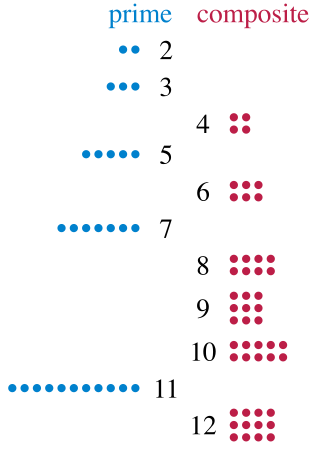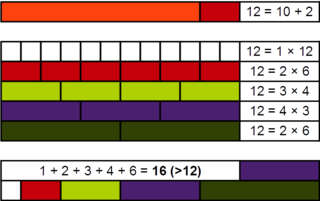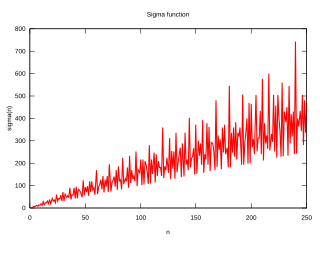Related Research Articles

A composite number is a positive integer that can be formed by multiplying two smaller positive integers. Accordingly it is a positive integer that has at least one divisor other than 1 and itself. Every positive integer is composite, prime, or the unit 1, so the composite numbers are exactly the numbers that are not prime and not a unit. E.g., the integer 14 is a composite number because it is the product of the two smaller integers 2 × 7 but the integers 2 and 3 are not because each can only be divided by one and itself.

The tables below list all of the divisors of the numbers 1 to 1000.
33 (thirty-three) is the natural number following 32 and preceding 34.
78 (seventy-eight) is the natural number following 77 and preceding 79.

In number theory, an abundant number or excessive number is a positive integer for which the sum of its proper divisors is greater than the number. The integer 12 is the first abundant number. Its proper divisors are 1, 2, 3, 4 and 6 for a total of 16. The amount by which the sum exceeds the number is the abundance. The number 12 has an abundance of 4, for example.
90 (ninety) is the natural number following 89 and preceding 91.
23 (twenty-three) is the natural number following 22 and preceding 24.
29 (twenty-nine) is the natural number following 28 and preceding 30. It is a prime number.
72 (seventy-two) is the natural number following 71 and preceding 73. It is half a gross or six dozen.
46 46(forty-six) is the natural number following 45 and preceding 47.
91 (ninety-one) is the natural number following 90 and preceding 92.
96 (ninety-six) is the natural number following 95 and preceding 97. It is a number that appears the same when turned upside down.
1000 or one thousand is the natural number following 999 and preceding 1001. In most English-speaking countries, it can be written with or without a comma or sometimes a period separating the thousands digit: 1,000.

360 is the natural number following 359 and preceding 361.
600 is the natural number following 599 and preceding 601.
2000 is a natural number following 1999 and preceding 2001.

1,000,000, or one thousand thousand, is the natural number following 999,999 and preceding 1,000,001. The word is derived from the early Italian millione, from mille, "thousand", plus the augmentative suffix -one.
100,000 (one hundred thousand) is the natural number following 99,999 and preceding 100,001. In scientific notation, it is written as 105.

In number theory, a colossally abundant number is a natural number that, in a particular, rigorous sense, has many divisors. Particularly, it is defined by a ratio between the sum of an integer's divisors and that integer raised to a power higher than one. For any such exponent, whichever integer has the highest ratio is a colossally abundant number. It is a stronger restriction than that of a superabundant number, but not strictly stronger than that of an abundant number.
50,000 is the natural number that comes after 49,999 and before 50,001.
References
- ↑ Weisstein, Eric W. "Composite Number". mathworld.wolfram.com.
- ↑ "Number 264 - Facts about the integer". Numbermatics.
- ↑ "About The Number 264". June 12, 2023.
- ↑ Sloane, N. J. A. (ed.). "SequenceA048242(Numbers that are not the sum of two abundant numbers (not necessarily distinct).)". The On-Line Encyclopedia of Integer Sequences . OEIS Foundation. Retrieved 2024-07-26.